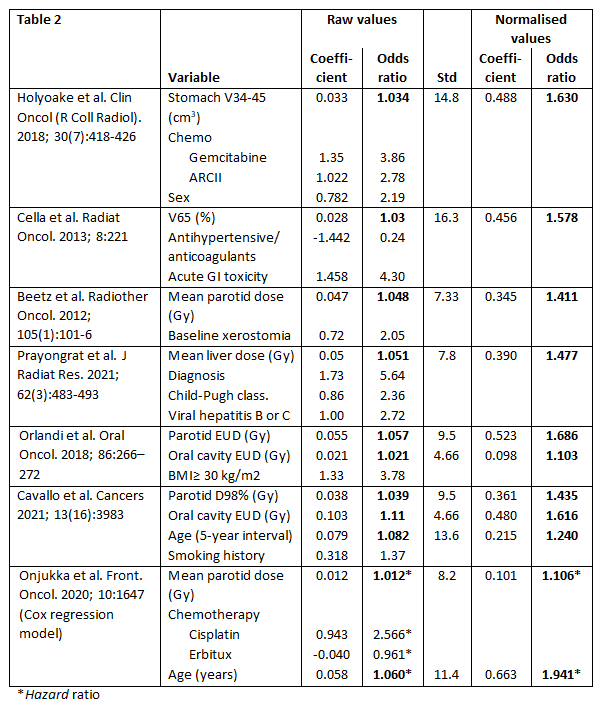Normalised odds ratios help understand the relative importance of dose in multivariable models
PO-2110
Abstract
Normalised odds ratios help understand the relative importance of dose in multivariable models
Authors: Emmy Dalqvist1, Tiziana Rancati2, Halla Ólafsdóttir3, Giovanna Gagliardi1, Gabriella Alexandersson von Döbeln3, Magnus Nilsson3, Fredrik Klevebro3, Eva Onjukka4
1Karolinska University Hospital , Department of Medical Radiation Physics and Nuclear Medicine, Stockholm, Sweden; 2Fondazione IRCCS Istituto Nazionale dei Tumori, Prostate Program, Milano, Italy; 3Karolinska Institutet, Department of Clinical Science, Intervention and Technology, Stockholm, Sweden; 4Karolinska University Hospital, Department of Medical Radiation Physics and Nuclear Medicine, Stockholm, Sweden
Show Affiliations
Hide Affiliations
Purpose or Objective
The odds ratio (or hazard ratio) of dose/volume parameters is often low in comparison to non-dosimetric variables in multivariable prediction models. As the odds ratio takes the inverse of the unit of continuous variables (e.g. % increase per Gy), the default units of the DVH could systematically fail to highlight the relative importance of the DVH as a predictor of normal-tissue complications. Normalisation of odds ratios for continuous variables offers a less arbitrary way of presenting the results, without changing the model, i.e. the p values and the AUC are unaffected. In the current analysis, the difference between raw- and normalised odds ratios is studied in a set of published multivariable models, and in a model of post-operative pulmonary complications (POPC) for patients with oesophageal cancer treated with neoadjuvant chemoradiotherapy in our institution.
Material and Methods
A retrospective analysis of 94 patients with oesophageal cancer treated with chemoradiotherapy followed by surgery was performed. Clinical and dosimetric variables were collected from a local quality registry and the radiotherapy treatment planning system. Multivariable logistic regression was performed, considering the damaged volume (DV) parameter (in cm3) from the critical volume model, in combination with ASA score and type of surgery. Normalisation of the regression coefficient was performed by multiplication with the standard deviation of the DV parameter in the cohort. The study was approved by the national ethics review authority.
For comparison, examples of multivariable models including dose/volume predictors were collected from the literature and the published regression coefficient of continuous variables normalised by multiplication with the standard deviation.
Results
Fourty patients (43%) suffered from POPC. Absolute lung DV was a significant predictor in univariable analysis (p=0.03), but not in multivariable analysis (Table 1). However, while the raw odds ratio implies an extremely low dependence of POPC on the DV parameter, the normalised odds ratio reveals a more similar relative importance of the three explanatory variables. Given the large standard deviation of the DV parameter measured by the default volume unit this effect was particularly strong.
A similar pattern was seen in the examples from the literature (Table 2). The mean raw odds ratio for dose/volume variables was 1.044 (per Gy, cm3 or %), while the mean normalised (unitless) odds ratio was 1.45.


Conclusion
The apparent relative importance of continuous variables in multivariable models, in terms of odds ratios, depends on the selected unit of the variable. Thus, the assessment of the role of dose/volume parameters in predictive models is facilitated by the reporting of normalised odds ratios alongside raw odds ratios.